Information Links
Related Conferences
Previous Issues Volume 2, Issue 1 - 2020
The Relevance of the “Charter of Rights against Unnecessary Pain” in the Framework of the Europe’s Beating Cancer Plan
Mariano Votta1*, Maira Cardillo2
1Director of Active Citizenship Network, c/o Cittadinanzattiva APS. Via Cereate, 6 - 00183 Rome, Italy 2Community & Fellowship Assistant at Active Citizenship Network. Via Cereate, 6 - 00183 Rome, Italy *Corresponding author Mariano Votta, Director Active Citizenship Network, c/o Cittadinanzattiva APS. Via Cereate, 6 - 00183 Rome, Italy, E-mail: [email protected]. Received Date: September 08, 2020 Published Date: October 12, 2020 Copyright: Votta M, et al. ©2020. Citation: Votta M, Cardillo M. (2020). The Relevance of the “Charter of Rights against Unnecessary Pain” in the Framework of the Europe’s Beating Cancer Plan. Mathews J Nurs. 2(1): 07.
ABSTRACT Chronic pain affects an estimated 100 million people across Europe [1]. Cancer related pain can be acute or chronic. Persistent cancer pain can, in some individuals, lead to the development of chronic widespread pain induced by plastic changes in the sensory nervous system [2]. Cancer survivors continue to live with physical and psychological symptoms associated with pain (such as cardiopulmonary compromise, fatigue, pain, neuropathies, depression and anxiety) [3] that interfere with the functioning of the patient’s body and mind and negatively affect his or her quality of life: • 66% will survive for at least 5 years and 40% will be alive more than 10 years after diagnosis [4]. • Between 33% and 40% of cancer survivors suffer from chronic pain, often neuropathic in nature [5]. For patients who live with a progressive advanced disease (incurable disease), pain is a very common symptom: 1.9 million European cancer patients die from their disease each year [6], 66% will experience pain before death and 55% will experience moderate‐to‐severe intensity pain [7]. The Europe’s Beating Cancer Plan represents the best occasion to better address the burden of cancer related pain, and the principled stated in the “Charter of Rights against unnecessary pain” could represent the ideal kaleidoscope with which to evaluate the effectiveness - from the point of view of patients and Patients Advocacy Groups (PAGs) - of the policies implemented by the European institutions. In fact, the “Charter of Rights against unnecessary pain” was promoted in order to obtain fair and adequate treatments that pay attention to the suffering that is felt in every moment of the disease among the adults, the elderly, and the children. KEYWORDS: Chronic pain; Cancer patients; Unnecessary pain; Patients’ rights; Cancer related pain; Charter of rights; Patients advocacy groups; Europe’s beating cancer plan INTRODUCTION The “Charter of Rights against unnecessary pain” has been promoted by the Italian NGO Cittadinanzattiva [8] with the aim to declare and protect a group of rights still too often violated. It is strictly linked with one of the principles stated in the “European Charter of Patients’ Rights” [9], a milestone that advocates on health issues at the EU and national level, in which is stated the Patients’ Right to Avoid Unnecessary Suffering and Pain, as follows: “Each individual has the right to avoid as much suffering and pain as possible, in each phase of his or her illness”. This case report aims at highlighting the relevance of the “Charter of Rights against unnecessary pain” in the framework of the Europe’s Beating Cancer Plan, 15 years after its promulgation and 10 years after the law on pain. MATERIALS AND METHODS The “Charter of Rights against unnecessary pain” was promoted by Cittadinanzattiva in 2005 with the aim to declare and protect a group of rights still too often violated. It was drawn up soon after the information campaign “Let’s abolish unnecessary pain” [10] and has benefited from the collaboration of a number of people active in the field: Italian Association of Family Doctors (AIMEF), Italian Association of Medical Oncology (AIOM), National Association of Rheumatic Patients (ANMAR), Le Molinette Hospital of Turin (ANTEA onlus), Italian Federation of General Practitioners (FIMMG), Italian Society of Anesthesia, Analgesia, Reanimation and Intensive Therapy (SIAARTI), Italian Society of Hospital Pharmacists (SIFO), Italian Society of General Medicine (SIMG), Italian Society of Orthopedics and Traumatology (SIOT), Italian Society of Rheumatology (SIR). The following Charter intends to inform citizens about pain and promote its prevention, control and treatment; the subscription to the Charter is entrusted to citizens’ organizations involved in safeguarding health rights, as well as healthcare professionals and the institutional bodies exerting governing responsibilities at different levels. The document is hosted and available for the free download in the new section of the website of Active Citizenship Network [11].
1) RIGHT NOT TO SUFFER UNNECESSARILY
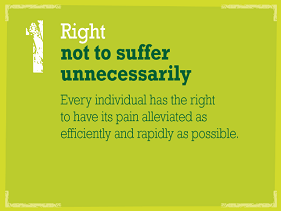 Every individual has the right to have his/her pain alleviated as efficiently and rapidly as possible.
Every individual has the right to have his/her pain alleviated as efficiently and rapidly as possible.
In the past, ignorance, prejudice and resignation have prevented to adequately address pain associated with disease. In fact, pain is a symptom that should be treated with the same care used in preventing the disease in order to avoid it becoming chronic and thus become a "disease" in itself. It is therefore necessary to build a new cultural approach towards suffering and unnecessary pain and make pain therapy an integral part of the therapeutic process. Every individual has the right to know that pain must not be necessarily tolerated, but that much of the suffering can be relieved and cured by intervening with the right therapy. Pain must be eliminated, or at least mitigated where possible since it heavily affects the quality of life. It is a right which must be recognized and respected always and everywhere, from hospital wards to long term care facilities, from the emergency rooms to the patients’ homes.
2) RIGHT TO THE ACKNOWLEDGEMENT OF PAIN
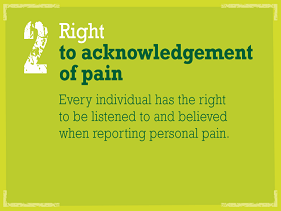 Every individual has the right to be listened to and believed when reporting personal pain.
Every individual has the right to be listened to and believed when reporting personal pain.
Pain has a strong subjective component, since the individual who is suffering from it is affected by many factors, as clearly shown by the literature on this issue. To intervene in a more appropriate manner, operators have a duty to listen, believe and consider the suffering. Citizens must be free to report the pain, with their own way of describing it and feeling it, without fear of the doctor’s judgment, which in turn has the duty to interpret in the best way what the patient is trying to communicate.
3) RIGHT TO ACCESS PAIN THERAPY
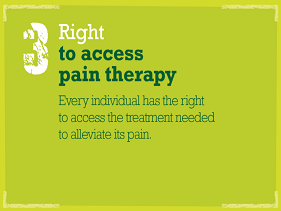 Every individual has the right to access the treatment needed to alleviate pain.
Every individual has the right to access the treatment needed to alleviate pain.
There are currently still many limitations regarding access to pain relief. The greatest obstacle is represented by a cultural bias, which persists in the medical profession, also due to the lack of specific training for both university students and professionals. In addition to these resistances there are also excessively rigid procedures, such as the failure to consider certain types of pain, concerns of an economic-financial nature and the widespread inadequacy of health facilities. To make the treatment of pain accessible what are essential are the recognition and the sharing of a series of key requirements: • Consideration and care for the pain experienced by the patient should be a quality standard in the professional and an ethical duty of the entire team of operators, regardless of ethical, religious or philosophical beliefs, in order to ensure the assisted the best possible quality of life; • All types of pain deserve equal consideration, no matter what the pathology or event that may have caused it. Therefore, even people nearing the end of their life and those who suffer from chronic non-cancer pain and acute pain (childbirth, trauma from surgery or those who need to be treated at A&E) have the equal right to be cared for. Furthermore, in particular, all women should be allowed to decide (according to their clinical situation) whether to give birth without pain; • Public health services must be able to provide adequate assistance to pain both inside and outside health facilities. The latter should provide a service in pain therapy (simple or complex, depending on the quality and quantity of services provided) qualitatively compliant with the latest international guidelines and able to ensure appropriate treatment to all those in need. Access to treatment on the territory must be guaranteed especially through home services referring to the World Health Organization (WHO) guidelines, ensuring an easier availability of prescription and administration of medication and avoiding the suspension of continuity of care; • Drugs and techniques for the treatment of pain, and all the technical stages for their correct administration, must be among the public health system services offered to all citizens. Every individual has a right to access innovative procedures according to international standards, without economic or financial impediments.
4) RIGHT TO QUALIFIED ASSISTANCE
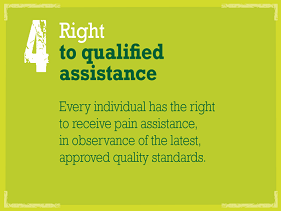 Every individual has the right to receive pain assistance in observance of the latest approved quality standards.
Every individual has the right to receive pain assistance in observance of the latest approved quality standards.
Everyone has the right to receive assistance to relieve pain by properly trained and updated professionals, so as to guarantee the respect of the international quality standards. It is necessary that the knowledge of the issue of "pain" (now considered the fifth vital sign), its quantification (measurement of pain) and treatment options become professional skills among all health operators, in order to guarantee citizens alleviation of their suffering, even in the absence of specialists. It is important for the measurement of pain to be carried out through validated methods at an international level and its registration to be indicated in the medical record. It is unacceptable that, even when laws provide tools to facilitate the prescription of opiate drugs, patients are denied the preparation or those doctors and practitioners are unprepared or unavailable.
5) RIGHT TO CONTINUED ASSISTANCE
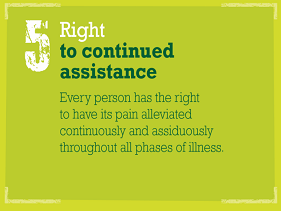 Every person has the right to have his/her pain relieved continuously and assiduously throughout all phases of illness.
Every person has the right to have his/her pain relieved continuously and assiduously throughout all phases of illness.
Pain should be regularly monitored in all phases of the disease; continuity of care could be hindered by inadequate attention to the development of the disease and the absence of the necessary therapy readjustment. Particular attention should be placed in the transition from hospital to the territory, avoiding situations of discontinuity or unavailability of operators or unavailability of drugs and hospitals.
6) RIGHT TO A FREE, INFORMED CHOICE
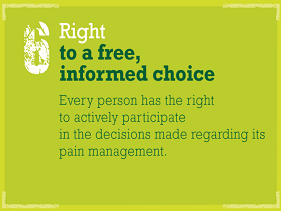 Every person has the right to actively participate in the decisions made regarding pain management.
Every person has the right to actively participate in the decisions made regarding pain management.
All decisions involve correct, complete and clear information, taking into account the cultural level of the patient and his/her emotional state. Any therapeutic intervention aimed at relieving the suffering must be agreed upon and regulated according to both quality and intensity, in agreement with the full and informed will of the patient, according to the principles which underpin a good informed consent. Every person has the right to receive prompt and clear answers to questions and have all the time necessary to take the resulting decisions.
7) RIGHTS OF CHILDREN, THE ELDERLY AND THOSE “WITHOUT A VOICE”
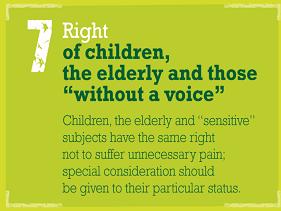 Children, the elderly and “sensitive” subjects have the same right not to suffer unnecessary pain; special consideration should be given to their particular status.
Children, the elderly and “sensitive” subjects have the same right not to suffer unnecessary pain; special consideration should be given to their particular status.
The assessment and treatment of pain in children has been ignored for a long time. The medical establishment, in fact, is often happy to transfer to children the knowledge already developed by treating adults rather than undertake research and specific studies, which take into account childhood and its psychological implications. Fear and anxiety present in all individuals dealing with the disease are different in ill children, in people with mental illnesses or severe mental disabilities and some elderly patients. These patients have difficulty in expressing their pain and therefore its reading is not recorded properly due to the lack of an integrated approach.
8) RIGHT NOT TO SUFFER PAIN DURING INVASIVE AND NON-INVASIVE DIAGNOSTIC TESTS
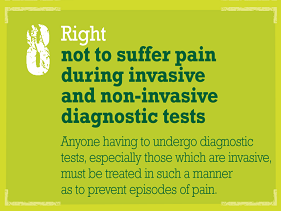 Anyone having to undergo diagnostic tests, especially those which are invasive, must be treated in such a manner as to prevent episodes of pain.
Anyone having to undergo diagnostic tests, especially those which are invasive, must be treated in such a manner as to prevent episodes of pain.
Some invasive diagnostic exams are not calmly faced when there is fear for the pain they can cause.
RESULTS AND DISCUSSION
The above-mentioned Charter, with its principles, represents one of the main instruments that allowed citizen organizations and PAGs to make visible the invisible in chronic pain, first at the national level in Italy, then at the EU level. In Italy, for instance, the principles stated in the Charter inspired the national law on pain drafted in 2010 [12], considered innovative compared to norms in other countries. At the European level, year after year, also due to the spread of the principles of the Charter, the constituency of the advocacy groups active on the topic of pain, cancer and non-cancer related, has increased more and more. Together with experts and scientific societies, citizen organizations and PAGs - including Cittadinanzattiva and its EU branch Active Citizenship Network [13] - have also contributed to increase the commitment of the European institutions on the issue: the last European Council, Parliament and Commission have been probably the Institutions that, in the history of the European Union, have shown with facts to be more attentive to the needs of the European citizens suffering from chronic pain, and this attention represents an important heritage for the new European Institutions that are called to give continuity and, hopefully, to improve on what their predecessors have done. Without any doubt, much of what has been achieved at least in the last five years is due to the great work done by the “Societal Impact of Pain” (SIP) platform, the multi-stakeholder partnership which aims to raise awareness of pain and change pain policies, in which Active Citizenship Network is connected since many years. CONCLUSIONS The relevance of the principles set out in the above-mentioned Charter is quite evident with reference to the new Europe’s Beating Cancer Plan that will be published by the European Commission by the end of 2020. The new European cancer plan will set out actions that support, coordinate or supplement Member States’ efforts to improve the prevention, detection, treatment and management of cancer in the EU. According to the “Societal Impact of Pain” platform, pain is the most common symptom of cancer at diagnosis [14] and rises in prevalence throughout and beyond cancer treatment [15]. If most cancer pain is caused by a tumor pressing on bones, nerves or other organs in the body, pain can also be related to cancer treatment. It is necessary to join efforts to reduce significant inequalities in access to cancer treatments across Europe. For sure, it is still valid the message underlined during the Italian Presidency of the Council of the European Union in 2014: “It is of fundamental importance to guarantee access to pain therapy (…) to reduce the existing inequalities in healthcare between regions and Member States of the European Union in the area of equal rights to health” [16]. In that occasion, the EU Institutions have also underlined the key role of the civic society in the field "…it is important to remember the contribution of non-profit associations toward the development and growth of the palliative culture; and the promotion of initiatives to strengthen and support civic organizations in their work to help patients suffering from pain and patients requiring palliative care. It is vital that patients are of their rights and able to make informed choices”. Civic and patients organization have fought for a long time to obtain respect for the right not to suffer, still poorly present in the national legislation, underestimated by the public opinion and only recently taken into due consideration at the European level. The Europe's Beating Cancer Plan is an opportunity to give new attention to the topic. For this reason, we do not want the right to avoid unnecessary pain and suffering to become a rearguard battle, penalizing the quality of life of those who already have a disease, making the condition heavier and more unbearable, depriving the person of a perspective and a life project. All the more so in emergency contexts like this one we are living with the Covid-19 pandemic.
As an organization which promotes citizens' activism for the protection of rights, the care of common goods, the support for people in conditions of weakness, Cittadinanzattiva will continue to engage at the European level through its branch Active Citizenship Network to promote and make enforceable the principles stated in the "Charter of Rights against unnecessary pain", by monitoring and denouncing the obstacles that do not allow citizens to enforce these principles, but also by enhancing good practices across Europe. To this end, with the third edition of the “EU Civic Prize on Chronic Pain - Collection of good practices” [17] Active Citizenship Network continues to highlight existing successful experiences in several European countries in terms of struggle against pain [18], to expand the “agora” of operators of good practices on pain and to encourage the exchange of experiences among health professionals, healthcare providers, Institutions, civic associations, and patient advocacy groups.
REFERENCES
1. Breivik H, Collett B, Ventafridda V, Cohen R, Gallacher D. 2006. Survey of chronic pain in Europe: prevalence, impact on daily life, and treatment. Eur J Pain. 10(4):287-333. 2. Evaa K, Miltonb C, Ralfc B, Gebhart, Gerald F, et al. (2016). Do we need a third mechanistic descriptor for chronic pain states? PAIN. 157(7):1382-1386. doi: 10.1097/j.pain.0000000000000507. 3. Bruehl S, Burns JW, Chung OY, Chont M. (2009). Pain-related effects of trait anger expression: neural substrates and the role of endogenous opioid mechanisms. Neuro sci Biobehav Rev. 33(3):475–91. doi:10.1016/j.neubiorev.2008.12.003. PMID 19146872. 4. Pergolizzi Jr. JV, Raffa RB, Taylor Jr. R. (2015). Treating Acute Pain in Light of the Chronification of Pain. Pain Management Nursing. 15(1):380-390. 5. World Health Organization. Europe data and statistics. Available from: http://www.euro.who.int/en/health-topics/noncommunicable-diseases/cancer/data-and-statistics 6. Europe’s Beating Cancer Plan. Available from: https://ec.europa.eu/info/law/better-regulation/have-your-say/initiatives/12154-Europe-s-Beating-Cancer-Plan. 7. Change Pain- Taking care of pain. Available from: http://www.change-pain.com/grt-change-pain-portal/change_pain_home/acute_pain/pain_basics/definition_of_pain/pain_is.../en_EN/318500008.jsp. 8. Cittadinanzattiva. Available from: www.cittadinanzattiva.it. 9. EUROPEAN CHARTER OF PATIENTS’ RIGHTS. Available from: http://www.activecitizenship.net/charter-of-rights.html. 10. Aboliamo i dolori forzati. https://www.cittadinanzattiva.it/progetti-e-campagne/salute/dolore-cronico/307-aboliamo-i-dolori-forzati.html 11. http://www.activecitizenship.net/charter-of-rights/from-the-charter-to-the-charters.html 12. Italian Law 15 March 2020 N.38 “Dispositions to guarantee access to palliative care and pain therapy. http://www.parlamento.it/parlam/leggi/10038l.htm 13. http://www.activecitizenship.net/ 14. http://www.euro.who.int/en/health-topics/noncommunicable-diseases/cancer/data-and-statistics 15. Breivik H, Cherny N, Collett B, deConno F, Filbet M, et al. (2009). Cancer‐related pain: A pan‐European survey of prevalence, treatment, and patient attitudes. Ann Oncol. 20:1420–33. 16. Beatrice Lorenzin, IT Minister of Health, in occasion of the Informal Council of EU Health Ministers, 2014. http://www.activecitizenship.net/files/patients_rights/Speech_Lorenzin_Handout_Delegate_packs_at_SIP_ENversion.pdf 17. http://www.activecitizenship.net/patients-rights/projects/332-european-civic-prize-on-chronic-pain-collecting-good-practices-iii-edition-2020-2021.html 18. To send successful experiences you can fill in the online form at the following link: http://www.activecitizenship.net/bp/2020/form/new.php.
.png)
.jpg)